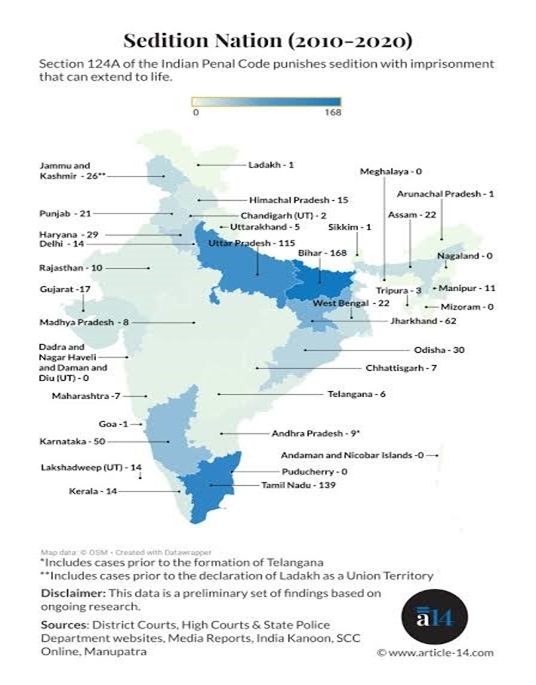CURRENT AFFAIRS
Get the most updated and recent current affair content on Padhaikaro.com
It’s time to define limits of sedition, says SC
- IAS NEXT, Lucknow
- 07, Dec 2021

Reference News:
The Assam Police have charged the editor and co-owner of a local news portal in the Barak Valley with sedition (under 124A) for an editorial deemed to promote enmity between the Assamese and Bengali-speaking people of the State.
- The Barak Valley is dominated by Bengalis and the Brahmaputra Valley by the Assamese speakers.
Background:
The sedition law has been indiscriminately used against critics, journalists, social media users, activists and citizens for airing their grievances about the governments COVID-19 management, or even for seeking help to gain medical access, equipment, drugs and oxygen cylinders, especially during the second wave of the pandemic.
What is sedition?
Section 124A of the IPC states, “Whoever, by words, either spoken or written, or by signs, or by visible representation, or otherwise, brings or attempts to bring into hatred or contempt, or excites or attempts to excite disaffection towards, the government established by law in shall be punished with imprisonment for life, to which fine may be added, or with imprisonment which may extend to three years, to which fine may be added, or with fine.”
Need for a proper definition?
The sedition law has been in controversy for far too long. Often the governments are criticized for using the law — Section 124-A of the Indian Penal Code (IPC) — against vocal critics of their policies.
- Therefore, this Section is seen as a restriction of individuals’ freedom of expression and falls short of the provisions of reasonable restrictions on freedom of speech under Article 19 of the Constitution.
The law has been in debate ever since it was brought into force by the colonial British rulers in 1860s. Several top freedom movement leaders including Mahatma Gandhi and Jawaharlal Nehru were booked under the sedition law.
- Mahatma Gandhi described it as the “prince among the political sections of the Indian Penal Code designed to suppress the liberty of the citizen.”
- Nehru had described it as “highly objectionable and obnoxious” which “should have no place in any body of laws that we might pass”. Nehru said, “The sooner we get rid of it the better.”
Relevant Supreme Court judgements:
- The Kedar Nath Singh vs State of Bihar case (1962):
While dealing with offences under Section 124A of the IPC, a five-judge Supreme Court constitutional bench had, in the Kedar Nath Singh vs State of Bihar case (1962), laid down some guiding principles.
- The court ruled that comments-however strongly worded-expressing disapprobation of the actions of the government without causing public disorder by acts of violence would not be penal.
- The Balwant Singh vs State of Punjab (1995) case:
In this case, the Supreme Court had clarified that merely shouting slogans, in this case Khalistan Zindabad, does not amount to sedition. Evidently, the sedition law is being both misunderstood and misused to muzzle dissent.

Recent views of Supreme Court:
The Supreme Court, in June 2021, said “it is time to define the limits of sedition”.
- The observation was made while dealing with the writ petitions filed by two news channels seeking the quashing of FIR and contempt petitions.
General observations made by the Court on Sedition:
- It is time we define the limits of sedition.
- Provisions of 124A (sedition) and 153 (promoting enmity between classes) of the IPC require interpretation, particularly on the issue of the rights of press and free speech.